Contents
Dwarf shrub barberry Thunberg “Inspiration” was created by hybridization in the Czech Republic. Frost-resistant culture quickly spread throughout the territory of the Federation. Barberry Thunberg tolerates dry summers well, shaded areas, undemanding to care for. Used in the design of the territory.
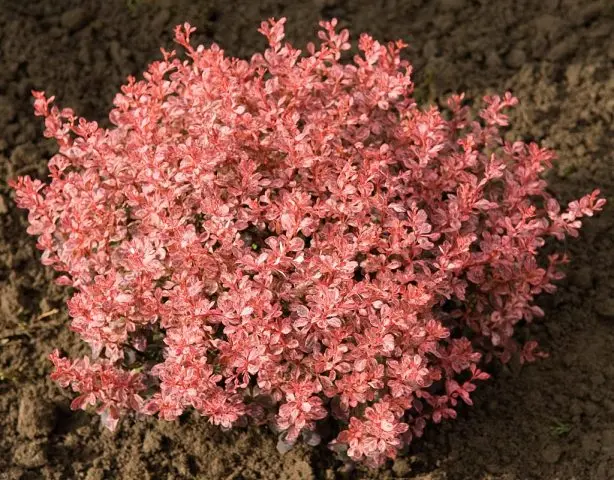
Description of barberry Inspiration
This is a relatively new variety of barberry, which was created specifically for landscape design. The fruits of the plant are bitter due to the high level of alkaloids, therefore they are not used for gastronomic purposes. Barberry Thunberg is a perennial deciduous variety. It reaches a height of 55 cm, forms a crown in the form of a circle with a diameter of up to 70 cm. Flowering begins in May.
Barberry “Inspiration” is a plant of slow vegetation, the growth per season is about 10 cm. It is the leader among crop varieties in terms of frost resistance. Favorably tolerates a drop in temperature to -250 C. Winters under snow without additional shelter. If the season is not snowy, the upper part of the young shoots may freeze, which are completely restored over the summer.
The guarantor of the attractiveness of the Inspiration Thunberg shrub is a sufficient amount of ultraviolet radiation. In shaded places, photosynthesis slows down, this is reflected in the decorativeness of the crown. It changes color to a monochromatic, darker one interspersed with green fragments.
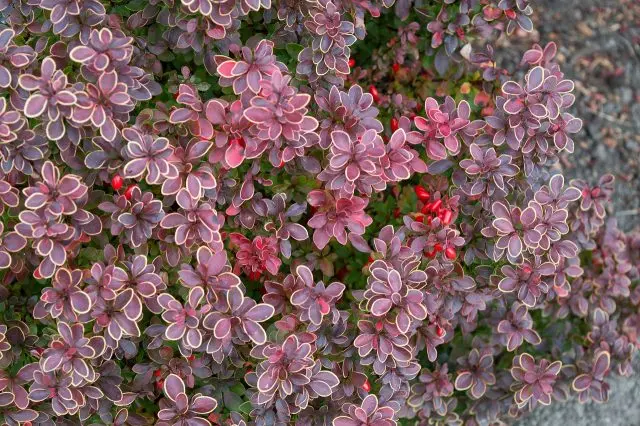
Description of barberry Thunberg “Inspiration” (shown in the photo):
- The thin branches of the shrub grow vertically. The crown is dense, compact, practically without gaps, spherical in shape. Young growth of bright burgundy color with a glossy surface. Older shoots are darker, with a brown tint.
- The Thunberg species “Inspiration” is in demand among designers because of the color of the bush. On one barberry there are leaves with white, red, purple spots on a light pink background. The leaves are small, spatulate, 1,2 cm in size. Rounded on top, narrowed at the bottom, tightly fixed, remain on the plant after autumn frosts.
- The thorn barberry “Inspiration” Thunberg is weak, the spines are short (up to 0,5 cm), simple.
- The culture blooms profusely with bright yellow flowers, collected in inflorescences of 4 pieces, or singly blooming on shoots. The variety is a honey plant, does not require cross-pollination.
- The berries of the barberry Thunberg are oblong, green in color at the stage of technical ripeness, after ripening they turn into a bright burgundy color. Well fixed on the stalk, do not fall off the bush until spring, due to the abundance of berries, the Thunberg barberry looks spectacular against the background of snow.
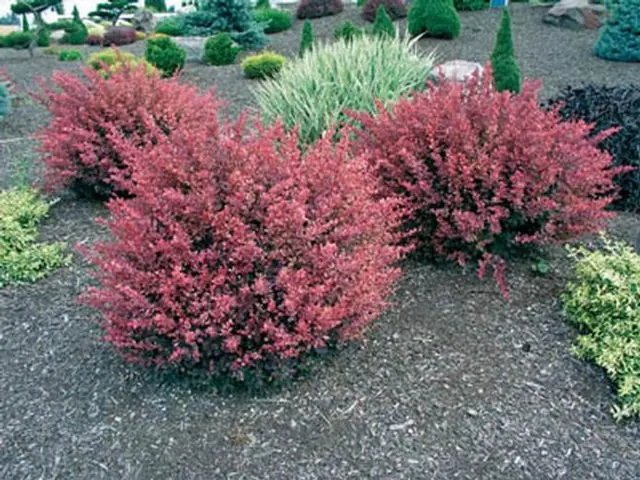
Barberry Inspiration in landscape design
Dwarf ornamental shrub is used for the foreground in a variety of compositions. Use as a single plant, or in combination with higher varieties of barberry. Planted in groups to form borders. The main use of the plant is home gardens, the front part of administrative buildings, flower beds in recreation parks. Barberry Thunberg, a dwarf species, is used to create:
- curbs along the garden path;
- foreground rabatok;
- accent in the center of the flower bed;
- restrictions on the zone of the reservoir;
- compositions in rock gardens;
- a concerted attention accent near the stones in the rockery.
Barberry is often used for shrub-woody compositions. Combine “Inspiration” with coniferous trees. Grown as a hedge. The Thunberg variety lends itself well to pruning, forming a hedge of various shapes.
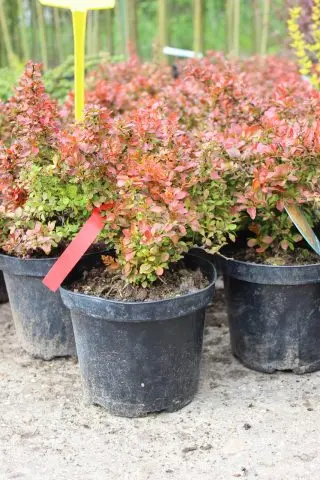
Planting and care
Barberry “Inspiration” tolerates temperature drops well, therefore it is grown in Siberia, the Urals and the entire territory of the European part of the Federation. The decorative effect of the crown is not affected by return spring frosts, the barberry will not lose flowers, and, accordingly, fruits by autumn. The Thunberg variety “Inspiration” can do without moisture for a long time, it is not afraid of high temperatures, this feature makes the barberry a frequent guest in the backyard of southerners. The plant is unpretentious in agricultural technology.
Seedling and planting preparation
It is customary to plant barberry Thunberg “Inspiration” in the spring, when the soil is completely warmed up, in regions with a temperate climate approximately in mid-May, in the South – in April. The autumn planting method is rarely used. A place for culture is chosen sunny, with good lighting, the color of the shrub will be saturated. Photosynthesis will not be affected by temporary shading. With a deficiency of ultraviolet light, the barberry will lose its decorative effect.
The culture grows well with a lack of moisture, an excess can lead to the death of the plant. The root system of the barberry is superficial, prolonged waterlogging leads to rotting of the root. The landing site is determined on a flat or elevated place, swampy lowlands are not suitable. An important requirement is the absence of closely lying groundwater. Barberry “Inspiration” does not tolerate the effects of the north wind; it is recommended to place the shrub on the south or east side.
The soil should be well-drained, slightly acidic or neutral. The plant feels comfortable on sandy soil, it can also grow on loamy soil. The plot has been prepared since autumn. Acid soil is neutralized with dolomite flour or lime. In spring, the soil will become suitable for planting barberries. Peat is added to the black soil. Planting material is used at the age of two. Seedlings are chosen with three shoots, with smooth dark red bark, without damage. The central root should be well developed, without dry areas, fibrous system without mechanical damage.
Rules of landing
When forming a hedge, the Thunberg barberry is placed in a trench. For a single landing, make a recess. A fertile mixture is prepared from equal parts, organic matter, peat, yellow sand. The depth of the pit is 45 cm, the width is 30 cm. If planting involves the formation of a hedge, 4 plants are placed per meter. When planting barberry “Inspiration” as an arabesque, the row spacing should be 50 cm. Algorithm of actions:
- They dig a recess, pour 25 cm of prepared soil into the bottom.
- The barberry is set in the center, the roots are distributed along the bottom of the pit.
- Cover the seedling with earth, leaving the root neck on the surface.
- Water the root with superphosphate diluted in water.
Watering and top dressing
A variety of “Inspiration” Thunberg is a drought-resistant plant. If it rains periodically in summer, the barberry is not watered. In dry summers without precipitation, the crop is irrigated early in the morning or after sunset. Young seedlings need watering throughout the season at least four times a month.
On fertile soils, top dressing is carried out in the spring before the leaves bloom with nitrogen-containing agents. After flowering, organic, phosphorus and potassium fertilizers are used. After the sap flow stops, the bush is watered abundantly.
Trimming
After planting, the Thunberg barberry is cut in half; over the summer, the culture forms a spherical crown. In the second year of vegetation, weak shoots, frost-damaged branches are removed, and the desired shape is given to the shrub by shearing. The following years, pruning is not required for a stunted bush. In early June, to give an aesthetic appearance, a sanitary cleaning is carried out.
Preparation for winter
In the absence of snow in regions with a cold climate, the bush is covered with spruce branches or dry leaves. Barberry “Inspiration” successfully winters under the snow cover. A prerequisite is mulching the root circle with a layer of sawdust (up to 10 cm).
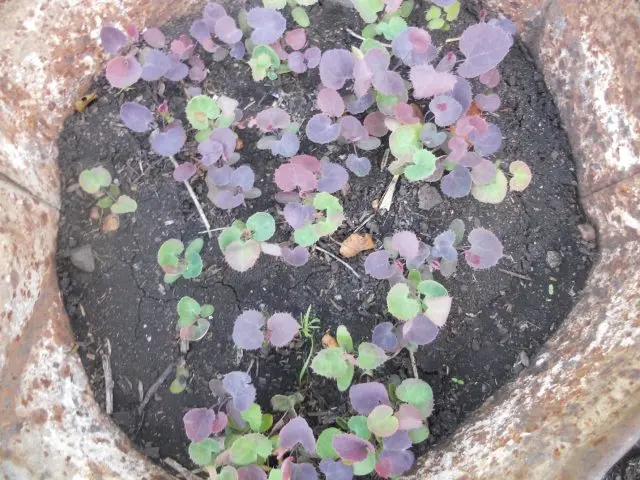
Reproduction
Thunberg barberry is propagated on the site by various methods. The generative method is very rarely used, since this work is laborious and lengthy. Seed germination is weak and does not provide the required amount of planting material. The advantage of generative breeding is the high resistance of the plant to infections. Barberry Thunberg grows on a temporary bed for two years, on the third it is determined for a permanent plot. This method is practiced in nurseries for commercial cultivation.
Acceptable ways for gardeners:
- The division of the mother bush. At least four strong trunks and a branched root system are left on each part.
- layering. Drop the bottom shoot. At the end of August, fruit buds form a root, cut seedlings, plant them in a garden bed, where they grow for a year, then place them on the site.
- Cuttings of a one-year shoot. The material is planted in a temporary place, covered. A year later, the Thunberg variety “Inspiration” is ready for breeding.
The culture after the transfer takes root well, very rarely young seedlings die.
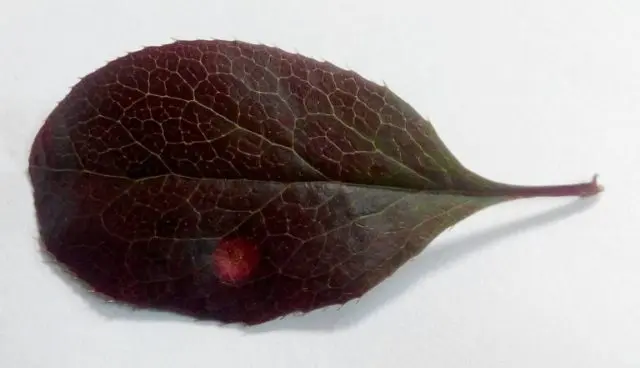
Diseases and pests
Thunberg’s “Inspiration” is not considered a resistant species that can withstand a fungal infection. Most often affected:
- bacterial cancer;
- necrosis of the cortex;
- bacteriosis;
- powdery mildew.
The Thunberg variety “Inspiration” is treated with fungicides: “Skor”, “Maxim”, “Horus”.
Spider mites and aphids parasitize bushes. They get rid of pests with insecticides: Aktellik, Engio, Aktara. For preventive purposes, barberry is sprayed with Bordeaux liquid in the spring.
Conclusion
Barberry Thunberg “Inspiration” is a dwarf ornamental shrub. Deciduous culture attracts landscape designers with exotic crown color. The culture is unpretentious in agricultural technology, tolerates low temperatures well. Used to create borders, hedges, foreground compositions.









